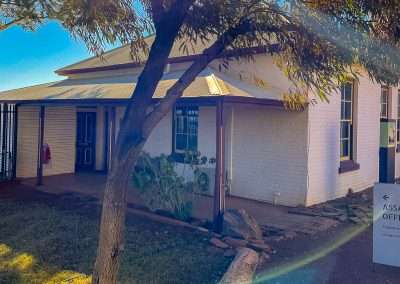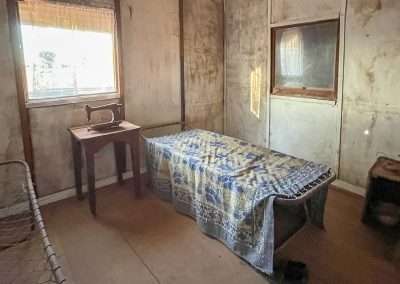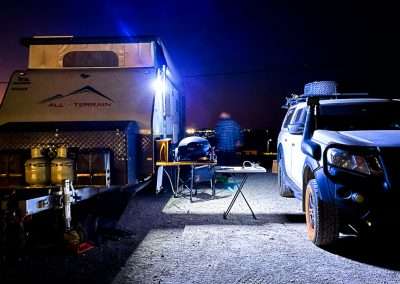Gwalia Ghost Town: Explore & Camp Inside Goldfields History
We experience the history of Gwalia Ghost Town. Maybe Australia’s best preserved gold mining site with free camping, ghost town. After a few great days camping at Gwalia Ghost Town we can share what an incredible spot it is.
Located just outside Leonora in Western Australia Gwalia offers more than just eerie, abandoned buildings. It’s a window into Australia’s gold mining past complete with a quirky charm and historic beauty. If you’re into history, ghost towns or just the thrill of camping somewhere a little out of the ordinary. Then Gwalia is a must see.

IMG 3289
Table Of Contents
- What Is At Gwalia Ghost Town?
- Getting There: The Journey from Laverton to Gwalia
- Camping At Gwalia Ghost Town
- Facilities At The Campsite
- Is It Safe to Camp at Gwalia?
- Things to Do While Camping at Gwalia Ghost Town
- Historical Insights: The Sons of Gwalia Mine
- The Weather at Gwalia Ghost Town
- What to Expect When Driving from Laverton to Gwalia
- Location And Contact Information
- Final Thoughts on Camping at Gwalia Ghost Town
- Gwalia Ghost Town Photo Gallery
- FAQs Frequently Asked Questions About Camping At Gwalia Ghost Town
- Is it safe to camp at Gwalia Ghost Town?
- Are there any facilities at the campsite?
- Can I light a campfire at Gwalia Ghost Town?
- What can I do while camping at Gwalia Ghost Town?
- When is the best time to camp at Gwalia Ghost Town?
- Do I need a 4WD to get to Gwalia Ghost Town?
What Is At Gwalia Ghost Town?
Gwalia Ghost Town is one of the best preserved historic mining towns in Australia. Once a bustling gold mining settlement in the late 1800s and early 1900s. Gwalia was home to thousands of people mostly European migrants. Today it’s a ghost town with only nobody living there. Its abandoned buildings stand as a silent reminder of Australia’s gold rush days.
The town grew up around the Sons of Gwalia Mine, a gold mine that operated from 1896 until 1963. When the mine shut down most of the town’s population left almost overnight. Leaving houses, shops and even a boarding house standing eerily empty. What remains is a living museum of sorts, with many of the original structures still intact and a rich history to uncover.
Getting There: The Journey from Laverton to Gwalia
Our trip to Gwalia began at Giles Breakaway 50 kilometres east of Laverton WA. We called in at Laverton to do some chores – emptying the toilet cassettes out of the caravan and that kind of thing. We had a look around Laverton including a stop at the Tourist Information Centre for some lunch and some information.
From Laverton you only have another 120 kilometres or so to Leonora, Gwalia is on the outskirts of Leonora. The drive took us along a pretty straightforward route heading west on Goldfields Highway. It’s an easy drive on sealed roads so you won’t need a 4WD unless you plan on doing some off-road adventuring in the region.
The landscape along the way is classic outback – wide open plains, scrubby bushland and the occasional rocky outcrop breaking up the horizon. Keep an eye out for wildlife; we saw kangaroos and emus along the way and there’s always the chance of spotting a wedge-tailed eagle soaring overhead. Weirdly enough we also saw a heap of dead cows that had been hit by road trains. We’ve done hundreds of thousand of kilometres in the outback and only ever seen a few dead cows previously.
As you approach Gwalia from Leonora the landscape becomes more hilly and you’ll start to see remnants of the gold mining industry scattered about. The first real sign of the town is the towering headframe of the old Sons of Gwalia mine. A striking reminder of the area’s mining heritage.

Abandoned Hotel WA Goldfields State Hotel Gwalia
Camping At Gwalia Ghost Town
Camping at Gwalia Ghost Town feels like stepping back in time. The free campsite is located at the Gwalia Museum, which preserves much of the town’s history. The campsite itself is basic but comfortable. It’s perfect if you’re looking for a free camping experience with a historical twist. There’s a donation box inside the museum entry. We made a donation as we really appreciated the campsite and the museum.
Facilities At The Campsite
The free campsite is right alongside the museum. It offers a large flat area overlooking the ghost town where you can set up your caravan. There aren’t any amenities at all and you MUST be fully self contained, no water on the ground allowed. When you arrive you go into the museum and register to camp. You can camp for a maximum of 72 hours.
The highlight is the setting. You’re camping right above to the historic Gwalia ghost town. With views of the old mine workings and the rugged Goldfields landscape. It’s hard to beat the atmosphere of a ghost town at dusk. With the fading sunlight casting long shadows over the abandoned houses and the quiet open spaces around you.
There’s a dump point just outside of Gwalia as well as water available. Leonora is only five minutes away and it has everything you could possibly need. Fuel, a couple of pubs and also a supermarket and a hardware store.

Camping At Gwalia Free Camp
Is It Safe to Camp at Gwalia?
Yes, camping at Gwalia is safe. It’s a quiet, remote spot and you’re unlikely to have many neighbours apart from other campers or the occasional visitor to the museum. Just take the usual outback camping precautions—keep your food secure to avoid attracting wildlife and be mindful of the weather (more on that below). There’s no mobile reception here, but the museum has emergency contact options if needed.
Things to Do While Camping at Gwalia Ghost Town
Camping at Gwalia isn’t just about soaking up the eerie ghost town vibe. There’s actually quite a bit to do, especially if you enjoy history, bushwalking and photography. Here’s a list of things we did while staying at Gwalia:
- Explore the Gwalia Museum
The museum is an absolute beauty. It houses a large and interesting collection of mining artefacts. There are plenty of old photographs and displays about the history of the Sons of Gwalia Mine. You can also wander through the town itself exploring the old miner’s cottages, the state hotel and the Gwalia General Store. - Visit Hoover House
This grand old house, built in 1898, was the home of the mine’s manager, Herbert Hoover, who would later become the 31st President of the United States. It’s now a guesthouse and museum, with beautiful views over the mine and surrounding landscape. Even if you’re not staying there, it’s worth a visit to see how the other half lived during the gold rush. - Walk Around the Mine Headframe
The towering headframe of the Sons of Gwalia Mine is one of the most iconic sights in the town. It’s one of the largest timber headframes left in Australia and standing beneath it gives you a real sense of the scale of the mining operations that once dominated this area. - Photography
If you’re into photography, Gwalia has heaps of opportunities for you. The contrast between the decaying buildings, the harsh desert landscape and the brilliant blue skies makes for some incredible shots. - Walks Around the Town Buildings
There is some great walking around Gwalia. You’ll get stunning views of the Goldfields and a chance to spot local wildlife, including kangaroos and a variety of bird species.

Old Abandoned Bedroom At Gwalia
Historical Insights: The Sons of Gwalia Mine
The Sons of Gwalia Mine was once one of the most profitable gold mines in Western Australia. It produced over 2.6 million ounces of gold in its heyday. The mine was established in 1896 by Welsh miners, who named it after their homeland. Gwalia is the Welsh name for Wales.
A key figure in the mine’s early success was Herbert Hoover, who managed the mine in the late 1890s before going on to become a U.S. President. Under Hoover’s management the mine grew rapidly. It attracted workers from all over Europe, particularly Italy and Yugoslavia which gives Gwalia its distinctive multicultural history.
The mine operated until 1963 when it closed suddenly. This caused the population of Gwalia to plummet almost overnight. The closure left the town largely abandoned and today it remains one of the best preserved ghost towns in Australia.
The Weather at Gwalia Ghost Town
The weather in Gwalia is typical of the Goldfields region – hot, dry and sunny for most of the year. Summer temperatures can soar well above 40°C, so if you’re camping during these months, be prepared for the heat and bring plenty of water. Winter is much more pleasant, with cooler days and chilly nights, often dipping below freezing.
We camped in autumn which was perfect – warm enough during the day to enjoy exploring the town, but cool enough in the evenings.
What to Expect When Driving from Laverton to Gwalia
Driving from Laverton to Gwalia is a journey through the heart of Western Australia’s Goldfields and while the road is sealed, it’s still very remote. Along the way, you’ll pass through typical outback scenery—low, scrubby bush, red earth and the occasional rocky outcrop.
There are a few points of interest along the route including the historic town of Leonora about 5 km from Gwalia. Leonora is worth a quick stop to refuel, grab some supplies. Or you can visit the Leonora Heritage Trail, which tells the story of the town’s gold mining history.

Outback Way Sign Laverton WA
Location And Contact Information
Address: Tower Street, Leonora, Western Australia
GPS:
Phone: (08) 9037 7122
After Hours: 0419 958 199
Email: [email protected]
Final Thoughts on Camping at Gwalia Ghost Town
Camping at Gwalia Ghost Town is an unforgettable experience. The combination of its rich history, stunning desert landscape and eerie atmosphere make it a unique place to visit. Whether you’re a history buff, a photographer, or just someone looking for an off-the-beaten-path adventure, Gwalia is the perfect spot to pitch a tent and explore. Plus, it’s free, which makes it even better. If you’re planning a trip along the Great Central Road or exploring the Goldfields region, be sure to add Gwalia to your itinerary. You won’t regret it!
Gwalia Ghost Town Photo Gallery
Not Original But This Is How They’d Have Hung Them Up After work
Not Original But This Is How They’d Have Hung Them Up After work
FAQs Frequently Asked Questions About Camping At Gwalia Ghost Town
Is it safe to camp at Gwalia Ghost Town?
Are there any facilities at the campsite?
Can I light a campfire at Gwalia Ghost Town?
What can I do while camping at Gwalia Ghost Town?
When is the best time to camp at Gwalia Ghost Town?
Do I need a 4WD to get to Gwalia Ghost Town?
























